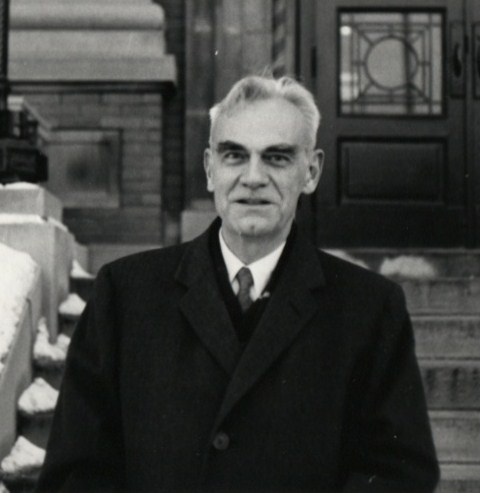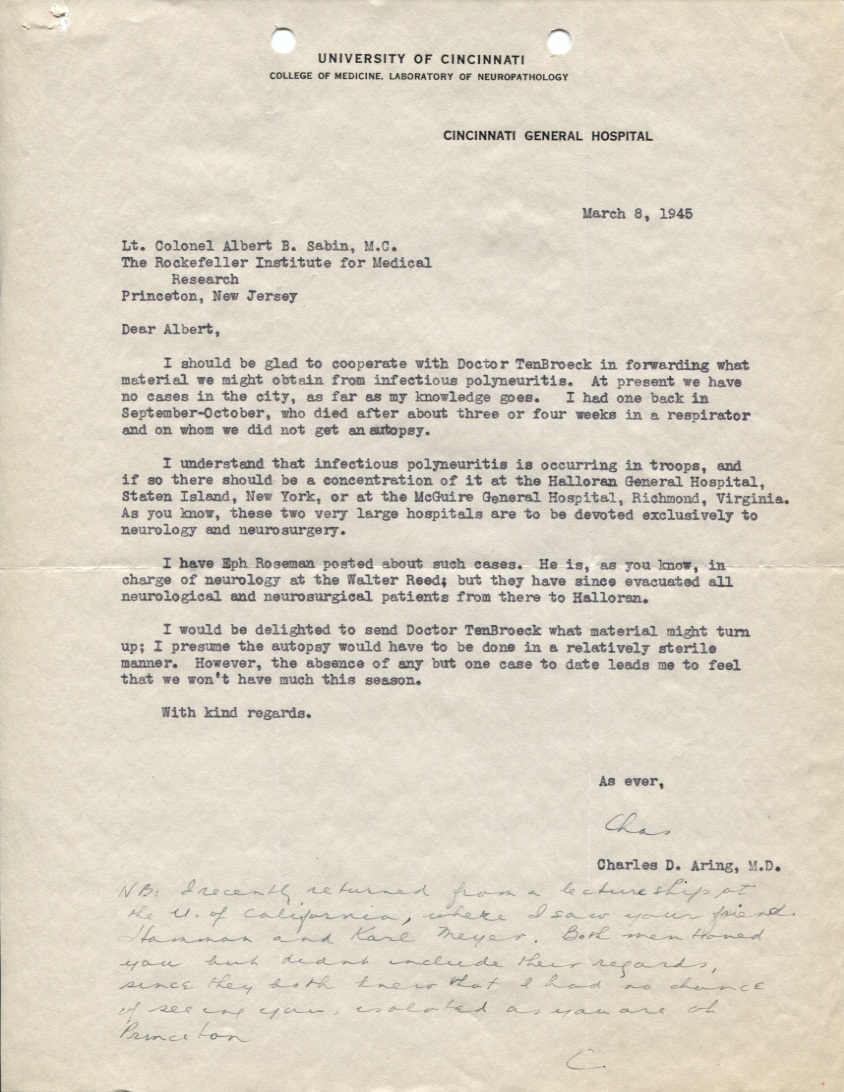Since I have started the next phase of the Sabin digitization project, I have encountered several letters between Dr. Sabin and Dr. Charles D. Aring, an internationally known neurologist who served as a professor and department chairman in the University of Cincinnati’s Department of Neurology from 1948-1974. It turns out that one of the Winkler Center student assistants, Miranda Scharf has been working to update the EAD-compatible finding aid for the Charles D. Aring papers, which reside in our archives. (Be on the lookout for an official announcement in the Winkler Center blog soon!) I thought I would highlight some materials in both of their manuscript collections to give you an idea of their relationship.
It appears that Drs. Sabin and Aring collaborated numerous times throughout the years. One example is an article that appeared in the July 1941 issue of The American Journal of Pathology. Dr. Sabin referred to this article in a letter to Dr. Aring from October 1944, which stated, “It may be of some interest to you that our joint paper on visceral lesions in infectious polyneuritis has apparently influenced the thinking about this disease among the medical officers in Italy. As a matter of fact, Headquarters had requested, about two weeks ago, that I be sent over to Italy to study these cases. However, because of the pressure of other work, this request was denied.”[1] We have a copy of this article, as well as handwritten versions with edits, in Dr. Sabin’s collection.[2]
While serving in the military during World War II, Dr. Sabin was involved in the Army Epidemiological Board’s Neurotropic Virus Commission (which changed its name several times during his participation). Through this Commission, he collaborated with many people, both in and outside of the military. He also drew on the knowledge of his colleagues and recruited them to assist when needed. Such was the case for Dr. Aring and the study of infectious polyneuritis in soldiers. Seen here to the left is a letter from Dr. Aring to Dr. Sabin agreeing to forward any infectious polyneuritis material that he might have come across in the Cincinnati area. From the 1945 letter, it appears that Dr. Aring did not seem optimistic in coming across any cases of infectious polyneuritis since he hadn’t seen any at the time of the letter.[3]
In October 1948, Dr. Aring took a trip to Japan on behalf of the Commission on Virus and Rickettsial Diseases of the Army Epidemiological Board for a post-epidemic survey of Japanese B Encephalitis. According to the annual report of the Commission, the purpose of Dr. Aring’s mission was “to determine whether or not an attack of Japanese B Encephalitis resulted in any deficiencies in nervous function after the acute stage of the disease had been passed successfully.” He concluded that the prognosis of the early acute state of the disease was good, but there was a possibility that those who suffered from Japanese B Encephalitis could potentially suffer from Parksinsonism.”[4] In Dr. Aring’s papers was a letter from the President of the Army Epidemiological Board, Colin M. MacLeod. The letter noted, “I believe that your evaluation of the possible late effects of Japanese B Encephalitis will be of the greatest value to the Army, and on behalf of the Army Epidemiological Board, I wish to thank you most sincerely for carrying out this investigation.”[5] I found Dr. Aring’s interactions with the Commission to be quite interesting, particularly because of the links between Dr. Aring and Dr. Sabin’s research during this period.
Many years later, Dr. Sabin was asked to write a letter nominating Dr. Aring for an award through the University of Cincinnati. Although Dr. Aring did not win the award, I found what Dr. Sabin wrote quite touching and revealed his long-lasting impression of Dr. Aring. He wrote, “Although [Aring] is only two years older than I, his wisdom always seemed to me in the early years of our association and collaboration far beyond his chronological age. Above all he has always been and continues to be an extraordinarily warm and compassionate human being. […] His mastery of neurology acquired by many years of ardent study and keen observation has been a boon to his students, his patients, his colleagues all over the world, and also to me when my own studies led me into fields of his special competence.”[6]
I definitely found the relationship between Drs. Sabin and Aring interesting and informative, especially how they found synergies among different specialties and how their friendship spanned across so many years. If you have any questions about either Dr. Sabin or Dr. Aring’s collections here at the Winkler Center, please contact chhp@uc.edu.
References
[1] Letter from Dr. Sabin to Dr. Aring, 27 October 1944. Found in the Charles D. Aring Papers, Series 1, Box 2, Folder 33 – Sabin, Dr. Albert B.
[2] Folder can be found in the Albert B. Sabin Papers, Series 2 Manuscripts, Box 2, Folder 17 – (75) Visceral lesions in infectious polyneuritis, 1941. The article citation is: Sabin AB, Aring CD. “Visceral Lesions in Infectious Polyneuritis: (Infectious Beuronitis, Acute Polyneuritis with Facial Diplegia, Guillain-Barré syndrome, Landry’s Paralysis).” The American Journal of Pathology 17 (1941): 469-482.
[3] Letter from Dr. Aring to Dr. Sabin, 19 December 1945. Found in the Albert B. Sabin Papers, Series 5 Military Service, Sub-Series Army Epidemiological Board/Neurotropic Virus Commission, Box 1, Folder 15 – Infectious Polyneuritis, 1945.
[4] “Annual Report of the Commission on Virus and Rickettsial Diseases of the Army Epidemiological Board” by John R. Paul, 19 April 1949. Found in the Charles D. Aring Papers, Series 1, Box 2, Folder 28 – Japan Trip, October 1948 (3).
[5] Letter from Dr. MacLeod to Dr. Aring, undated. Found in the Charles D. Aring Papers, Series 1, Box 2, Folder 28 – Japan Trip, October 1948 (3).
[6] Letter from Dr. Sabin to the University of Cincinnati, 11 March 1986. Found in the Albert B. Sabin Papers, Series 1 Correspondence, Sub-Series Individual, Box 1, Folder 32 – Aring, Charles D., 1985-1990.
In 2010, the University of Cincinnati Libraries received a $314,258 grant from the National Endowment for the Humanities (NEH) to digitize the correspondence and photographs of Dr. Albert B. Sabin. This digitization project has been designated a NEH “We the People” project, an initiative to encourage and strengthen the teaching, study, and understanding of American history and culture through the support of projects that explore significant events and themes in our nation’s history and culture and that advance knowledge of the principles that define America. Any views, findings, conclusions, or recommendations expressed in this blog do not necessarily reflect those of the National Endowment for the Humanities.


